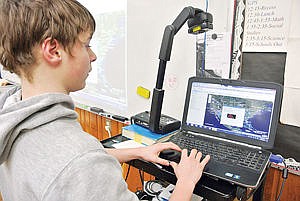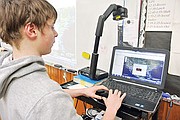Libby elementary students to use drone helicopter for mapping project
Libby elementary students are preparing to take their studies of GPS and geographic information system technologies to a new level – literally – with the addition of a camera-equipped drone helicopter into a curriculum that already includes an impressive array of high-tech hardware and software.
The sixth-grade elective course, now in its third year, began with hands-on lessons using GPS devices and branched out into the use of GIS software to create information-packed computerized maps. Class members are currently practicing with remote controlled, four-rotor “quadcopters” in preparation for the next step, which will bring a much more sophisticated drone copter into the mix.
“We’re one of the only elementary programs that does this stuff,” said teacher Dean Thompson.
Students in the course learn to use GPS with fun projects like “treasure hunts” for items hidden around the school, and locating and electronically marking potential safety hazards, Thompson said. Piggybacking on that technology, a mapping component was added to the course using the same GIS software used by the U.S. Forest Service and many other government agencies and private businesses.
A class project using the GIS software involved locating every high school in Montana on a map. An image of the school’s mascot shows the location, and when a user clicks on the image, a host of information about the school becomes available via a link to the Montana Office of Public Instruction’s website.
Mapping projects have been coordinated with studies in other classes. A lesson on ecosystems led the students to create maps that show different kinds of animals and their habitats around the world. A fifth-grade study of Montana ghost towns was followed up by the students the next year with a project showing the locations of the towns and information about each one.
Students also undertook individual projects with a “top 20” theme.
“I told them ‘top 20’ of anything they wanted to do,” Thompson said.
The class members were free to select subjects based on their own interests. Drew Ginther, a football fan, mapped out the schools where the top 20 NCAA running backs play, and clicking on the map brings up statistics on each player. Emily Managhan mapped out leading golf courses, and Kayley Svendsbye made a map that shows the location of Justice clothing stores.
To get ready for the integration of a drone helicopter into the course, students have been learning to pilot relatively inexpensive – about $80 each – quadcopters purchased locally from Scheer Brothers Hobbies. Grants have funded most of the technology used in the class, and enough money remains for the purchase of a camera-carrying drone priced at around $1,800, Thompson said.
Student Owen Wilkins has been working on his piloting skills with the radio-controlled “quads.” He said he’s noticed that they are easier to fly when new, but after some rough landings they can be harder to keep balanced in flight. Getting the quad to come back to the pilot can be the hardest part, he said, especially when it’s a long distance away.
“It will go so high you can barely see it,” he said. “It will just be a small dot.”
The drone the school is looking to purchase can be pre-programmed to fly a specific route, and to return automatically to where its flight started.
“By using a smart phone, you can actually tell the copter the route that you want it to go,” Thompson said.
Thompson and his students are already brainstorming ideas for projects that will utilize the drone’s camera. One idea is to make informational videos that can provide a virtual tour of features of the Libby community, such as Cabinet View Golf Club.
“If someone hasn’t seen the golf course and doesn’t know what it looks like, you could show them on the video,” Wilkins said.
The students have been quick to take to the technologies used in the class and often come up with their own tricks and shortcuts, Thompson said.
“Kids aren’t afraid to try something,” he said. “If they make a mistake, they just backtrack.”
The students are having fun, but they are also learning skills that can give them a head start for the future, Thompson said.



